It’s truly a “eureka” moment for Kepler scientists: the first rocky Earth-sized world has been found in a star’s habitable “Goldilocks” zone, the narrow belt where liquid water could readily exist on a planet’s surface without freezing solid or boiling away. And while it’s much too soon to tell if this really is a “twin Earth,” we can now be fairly confident that they do in fact exist.
The newly-confirmed extrasolar planet has been dubbed Kepler-186f. It is the fifth and outermost planet discovered orbiting the red dwarf star Kepler-186, located 490 light-years away. Kepler-186f completes one orbit around its star every 130 days, just within the outer edge of the system’s habitable zone.
The findings were made public today, April 17, during a teleconference hosted by NASA.
“This is the first definitive Earth-sized planet found in the habitable zone around another star,” says lead author Elisa Quintana of the SETI Institute at NASA Ames Research Center. “Finding such planets is a primary goal of the Kepler space telescope. The star is a main-sequence M-dwarf, a very common type. More than 70 percent of the hundreds of billions of stars in our galaxy are M-dwarfs.”

Unlike our Sun, which is a G-type yellow dwarf, M-dwarf stars (aka red dwarfs) are much smaller and dimmer. As a result their habitable zones are much more confined. But, being cooler stars, M-dwarfs have long lifespans, offering planets in their habitable zones — like Kepler-186f — potentially plenty of time to develop favorable conditions for life.
In addition, M-dwarfs are the most abundant stars in our galaxy; 7 out of 10 stars in the Milky Way are M-dwarfs, although most can’t be seen by the naked eye. Finding an Earth-sized planet orbiting one relatively nearby has enormous implications in the hunt for extraterrestrial life.
“M dwarfs are the most numerous stars,” said Quintana. “The first signs of other life in the galaxy may well come from planets orbiting an M dwarf.”
Read more: Earthlike Exoplanets Are All Around Us
Still, there are many more conditions on a planet that must be met for it to be actually habitable. But size, composition, and orbital radius are very important first steps.
“Some people call these habitable planets, which of course we have no idea if they are,” said Stephen Kane, an assistant professor of physics and astronomy at San Francisco State University in California. “We simply know that they are in the habitable zone, and that is the best place to start looking for habitable planets.”
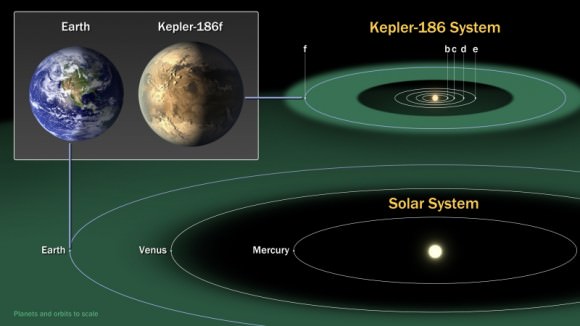
As far as the planetary system’s age is concerned — which relates to how long life could have potentially had to evolve on Kepler-186f’s surface — that’s hard to determine… especially with M-dwarf stars. Because they are so stable and long-lived, once they’re formed M-dwarfs essentially stay the same throughout their lifetimes.
“We know it’s probably older than a few billion years, but after that it’s very difficult to tell,” BAERI/Ames scientist Tom Barclay told Universe Today. “That’s the problem with M-dwarfs.”
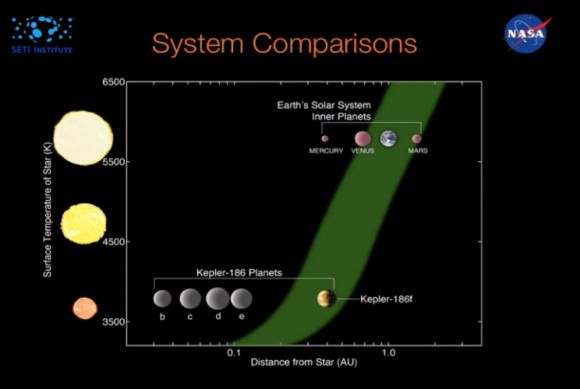
The exoplanet was discovered via the transit method used by NASA’s Kepler spacecraft, whereby stars’ brightnesses are continually monitored within a certain field of view. Any dips in luminance reveal the likely presence of a passing planet.
Because of its small size — just slightly over 1 Earth radius — and close proximity to its star, Kepler-186f can’t be observed directly with current telescope technology.
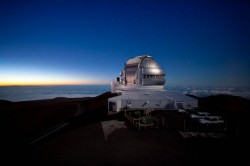
“However, what we can do is eliminate essentially all other possibilities so that the validity of these planets is really the only viable option,” said Steve Howell, Kepler project scientist and a co-author on the paper.
Using the latest advanced imaging capabilities of the Gemini North and Keck II observatories located atop Mauna Kea in Hawaii, astronomers were able to determine that the signals detected by Kepler were from a small orbiting planet and not something else, such as a background or companion star.
“The Keck and Gemini data are two key pieces of this puzzle,” Quintana said. “Without these complementary observations we wouldn’t have been able to confirm this Earth-sized planet.”
Kepler-186f joins the other 20 extrasolar worlds currently listed in the Habitable Exoplanets Catalog, maintained by the Planetary Habitability Laboratory at the University of Puerto Rico at Arecibo. To date 961 exoplanets have been confirmed through Kepler observations, with 1,696 total confirmed altogether. (Source)
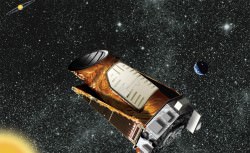
Read more: Mega Discovery! 715 Alien Planets Confirmed Using a New Trick on Old Kepler Data
Whether Kepler-186f actually resembles Earth or not, this discovery provides more information on the incredible variety of planetary systems to be found even in our little corner of the galaxy.
“The diversity of these exoplanets is one of the most exciting things about the field,” Kane said. “We’re trying to understand how common our solar system is, and the more diversity we see, the more it helps us to understand what the answer to that question really is.”
The SETI Institute’s Allen Telescope Array has surveyed the Kepler-186 system for any potential signals but so far none has been detected. Further observations are planned.
“Kepler-186f is special because we already know that a planet of its size and distance is capable of supporting life.”
– Elisa Quintana, research scientist, SETI Institute
The team’s paper, “An Earth-sized Planet in the Habitable Zone of a Cool Star” by Elisa V. Quintana et al., will be published in the April 18 issue of Science.
Learn more about the Kepler mission here, and read more about this discovery in NASA’s news release here and on the W.M. Keck website here.
Watch some video excerpts of team interviews and data renderings below:
Also, you can download the slides used in the NASA teleconference here.
Sources: San Francisco State University, Gemini Observatory, W.M. Keck Observatory, and SETI news releases

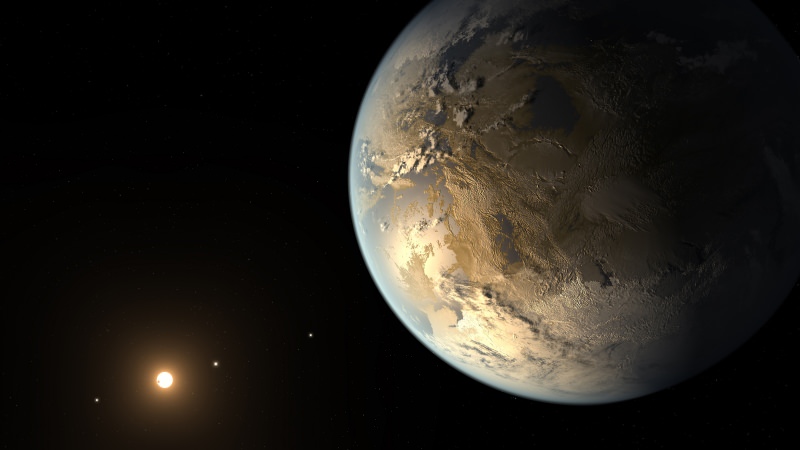
Sounds like a high priority for the improved parallax work of Hubble: http://phys.org/news/2014-04-hubble-stellar-tape-space.html
Someone seems to have posted some of the working data of the system – http://s1160.photobucket.com/user/Tony_Jebson/library/
Bit of an index page of various observations of the star from before are under http://simbad.u-strasbg.fr/simbad/sim-id?protocol=html&Ident=Kepler-186 (click the Aladdin applet if you use java.)
One general question I have about Seti searches and such methodologies is if anyone is searching in our system’s plane of transits. Maybe someone would spot our system and try to send messages to us (radio/laser, whatever)….
They would have to be within about 100 light years from us. If there was intelligent life on Kepler 186f, and they were using the same techniques we use to determine if there is intelligent life on Earth, they might determine habitability, but they would still not be able to prove any intelligent life exists on Earth. They would be looking for radio signals . . . but radio was not used until around the early 1900’s . . . and Kepler 186f is about 500-light years away . . . meaning that they would not be able to detect any of our signals until about 2400.
I see what you mean about finding us based on our signals (I hadn’t seen anything about distance but see now it is in the paper they submitted-turned-video above) but they could be sending a signal based on broader ideas. We sent messages to M13 without any such ideas. But Kepler 186, in Cygnus, isn’t anywhere near our ecliptic so not really my point – they can’t detect us by transits. But we’re plenty excited about this kind of planet in the habital zone and among all the systems in our transit region someone might think it worthwhile to send signals without proof of intelligent life.
Smkolins, that’s a great idea! There can’t be that many stars in our plane that are say 4000 ly away. You’d have to take into account our movement around the Milky Way (and the sample star’s movement) to determine which stars were aligned when. If a star is x ly distant AND it was in our plane x years ago, then that star would be a good candidate for a super-SETI evaluation. Maybe whenever they found an exoplanet with their Kepler, they sent a message via a laser … or whatever … to that exoplanet.
Heck, maybe we should be doing the same thing!
“The SETI Institute’s Allen Telescope Array has surveyed the Kepler-186 system for any potential signals…”
Just reading that excites me; the fact that we are in a time when, instead of systematically looking at random places, we can actually point to a location in the sky and say there’s a non-zero chance of receiving signals from ETI.
It does occur to me that they spent the coordination and effort to look for signals for intelligence vs the likelihood of doppler wobbles of the star for more/bigger planets or IR excess for an asteroid field. Perhaps the scientific community thinks intelligent life on earth-like situations is a higher probability or it could just be that it would be a far greater call of importance if found that it’s worth the risk even if it isn’t very likely any particular time. Someday it’ll hit….
The NASA team said “outermost” but I wonder – I see they have studied the system for four years and I’d guess that would catch transits out some distance but if their minimum positive is three transits I wonder if they say /any/ candidates for transits in those four years that didn’t match the known planets. They also said that the known planets were too small to show up in a doppler measure of the star’s wobble and so didn’t commission a study for that – perhaps from the above they didn’t see any confidence in transit candidates for a larger planet farther out.
I look forward to hearing of characterizations of the 186 system. Looks like they spotted a rotation period of the star and now tracking can try to find other patterns in the star like our 11 year sunspot cycle. But there are many examinations yet to be considered (excess IR for asteroid belts, are there stars in it’s neighborhood that could have had a close pass in the last million years like we have had/will have – https://en.wikipedia.org/wiki/List_of_nearest_stars#Future_and_past – i thought i saw a negative marker on the metalicity of the star which might mean metals might be relatively scarce in the system making a rocky or water world more likely ? and they should publish the transit dates so others could watch and add data even if it is beyond amateur scope sensativities )
In all the excitement, we need to remember that both Venus and Mars are in the habitable zone in our own system. The news splash, “We have found an Earth sized planet in the habitable zone.” gets quickly translated to “We have found another Earth.” While such builds excitement, which helps funding, it also gives a very false impression.
I somewhat agree – and the scales of simplification(and vs technical language and specialized acronyms) apply even to this meeting. For example i speculated above about some vague sense of metallicity – now that i had access to the actual paper i see they’ve done more particular work on that (but apparently not enough to strongly limit what the planets are likely made of.)
Not having finished the paper yet i still wonder about excess IR for an asteroid belt and a kuiper belt type of presence outside the outermost planet….
Here’s paper that says “~25 per cent of stars with inner planets have debris, (=dust that is seen in thermal emission in the far-infrared (FIR) by IRAS and the Infrared Space Observatory (ISO)) compared to ~10 per cent of similar stars without planets.” http://www.ast.cam.ac.uk/~wyatt/gfw05.pdf
Of course it’s all speculation, but the fact that the planet is in the outer edges of the HZ and is a bit larger than Earth looks to me like a very positive sign. It shouldn’t have Mars’ problem of losing its atmosphere; actually it should capture more since it’s larger that Earth….a good thing for an outer edge HZ planet. Also the solar flares associated with an M class star would have less adverse affects on life out there at the edge.